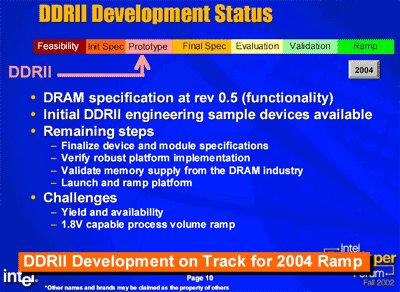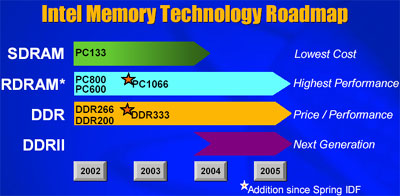Intel Developer Forum Fall 2002 - Hyper-Threading & Memory Roadmap
by Anand Lal Shimpi on September 16, 2002 6:05 PM EST- Posted in
- Trade Shows
Intel's Memory Roadmap - RDRAM or DDR II?
In the late 90's Intel made quite a few mistakes when it came to their chipsets. Intel tried to put all their weight behind one memory technology (Rambus) and designed all of their chipsets around the technology; Intel even designed CPUs around RDRAM (Timna) and it backfired in a major way. Motherboard manufacturers rejected Intel's first RDRAM chipset as the industry was not ready to switch to Rambus at that time which paved the way for VIA to rise to the top with a number of SDRAM equipped solutions.
Today Intel has learned from their mistakes and although many (us included) expected Intel to completely drop RDRAM from their roadmap, it turns out that they haven't. If Intel has truly learned from their mistakes the solution to their memory problems isn't to completely ditch one memory type, but to let fate play its role and let the industry decide what memory technology to embrace; luckily (for Intel's sake) that's what they seem to be doing.
By the end of this year Intel will adopt DDR333 support in their chipsets, but as of now there are no plans for DDR400 support citing the lack of an industry standard and difficulties in mass producing DDR400. Intel will also embrace PC1066 which ended up being no more than a simple mod to the motherboard design. What about after DDR333 and RDRAM?

Intel's current roadmap shows both DDR-II and RDRAM support moving forward, with DDR-II not arriving until 2004. This is refreshing to see as it does illustrate Intel learning from past mistakes - they're not tying themselves down to a single memory technology, a huge improvement over what we saw a couple of years ago.

As you can see from the roadmap above, RDRAM is aimed at only the highest market segments with DDR/DDR-II taking the mainstream. The one thing that Intel did mention was that the technology eventually embraced by the industry would have to accommodate all segments, this division according to price cannot continue for much longer. As far as which memory technology will prevail, thankfully Intel is leaving that up to the rest of the industry this time around.

Going forward there needs to be a single memory technology for all segments
(much like DDR today)
Until then, it looks like we'll see both RDRAM and DDR (and eventually DDR-II) support from Intel.
Final Words
On this note we conclude yet another week at the Intel Developer Forum, as always we'll be back in 6 months covering the Spring 2003 IDF in February.










0 Comments
View All Comments